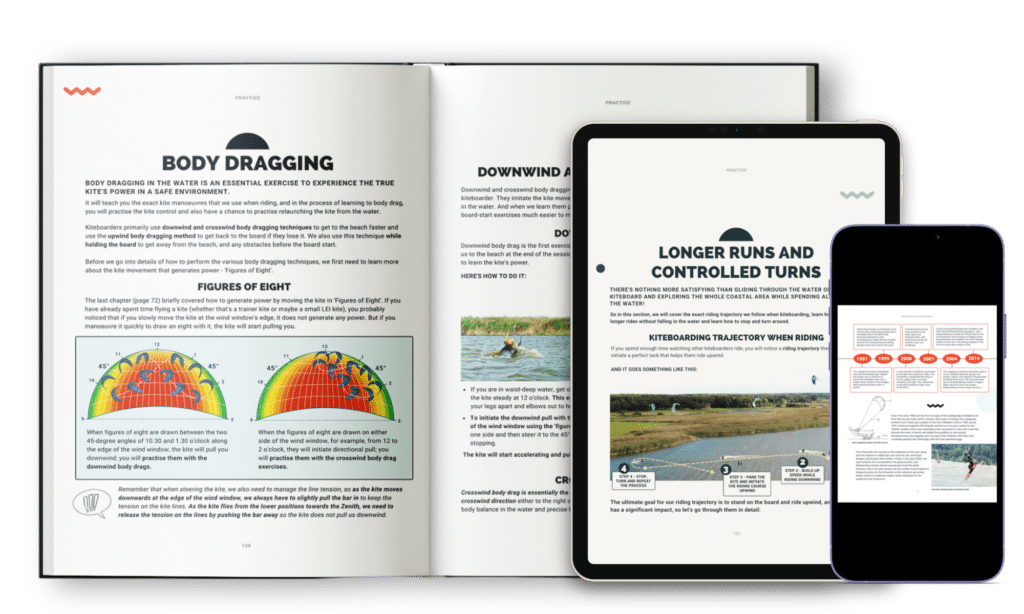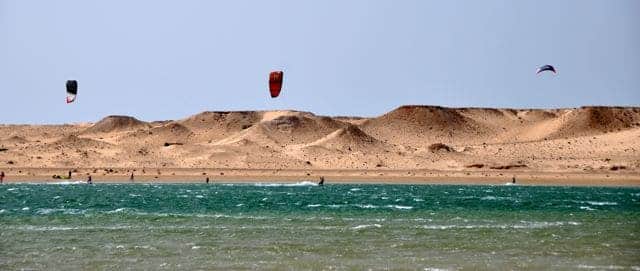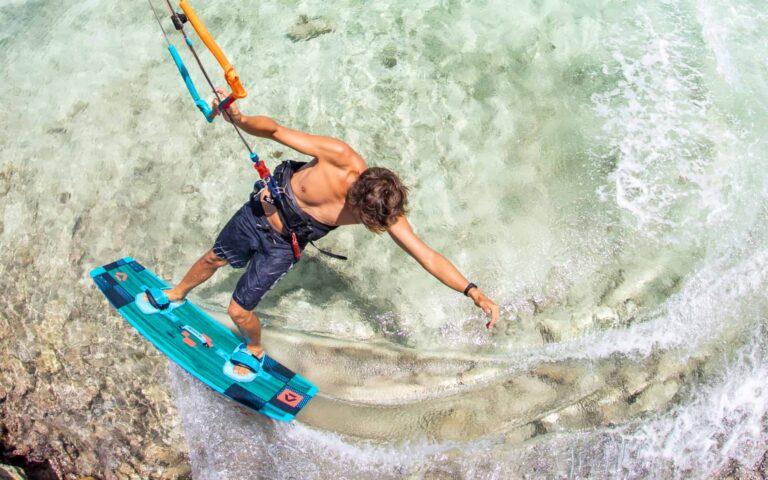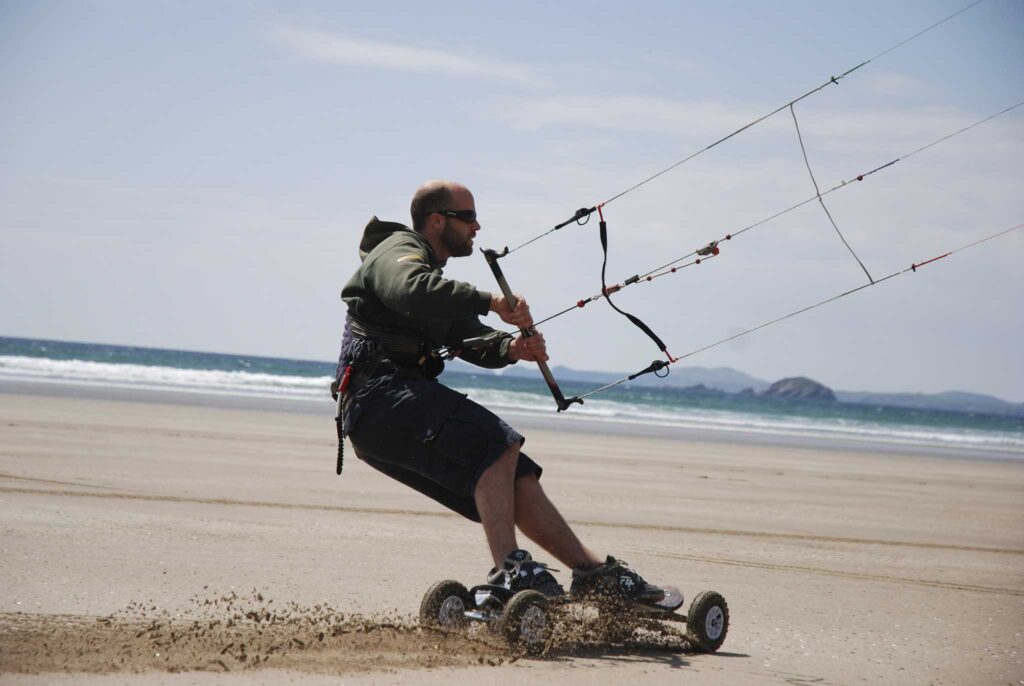Table of Content
The wind is the primary element in all kitesports and helps us to create speed and boosting power with the kite. We have to know how to read and describe the winds as it helps us not only to measure the wind correctly but it’s also the starting step to choosing a kite spot and assessing it to know that it is safe.
In this article, we will explain in detail, what are the wind directions and precise terminology and also how to the wind directions affect our choice for kitesports locations.
DESCRIBING THE WIND DIRECTION
There are two ways in which we can describe the wind direction; where it came from, and in relation to land and sea. As we define the wind by where it came from, we are referring to the compass points North, East, South, West and each of the points in between. For example, we could have a wind blowing from the South West. This would be called a South Westerly wind.
We can also describe the wind orientation in relation to the direction it blows over land and sea. Wind that blows from the sea onto land is called an onshore wind; wind that blows from the land out to sea is called an offshore wind. We also have cross-shore wind which blows parallel between land a sea and, again, the midpoints between each direction called cross-onshore and cross-offshore. We’ll cover the pros and cons of each wind direction below.

Onshore
Onshore winds blow onto the shore at a 90º angle. If you drop your kite and can’t relaunch it, or the wind speed drops and you can no longer ride upwind, this wind direction will return you directly to shore.
An onshore wind can bring own challenges though. In kite spots with a shore break, it can be difficult to get away from the beach. An onshore spot with a shore break is best suited to intermediate and experienced riders who can confidently ride upwind in all conditions. If the kite spot is quite flat and the water is shallow, an onshore wind is suitable for all level riders as they can walk further into the water before attempting to ride upwind.
Cross-onshore
Cross-onshore is the best wind direction for kiteboarding. The wind blows onto land at around a 45º angle allowing the rider to easily return to shore if they are unable to relaunch their kite or the wind drops leaving them unable to ride upwind.
Cross-onshore sea breezes tend to be a smooth consistent laminar air flow with little turbulence, providing consistent wind which is great for kitesurfing. For ease of riding, cross-onshore wind is suitable for all levels of riders as it is the easiest wind direction for kiteboarders to ride away from the beach.
Cross-shore (AKA Side-shore)
Cross-shore winds, also known as side-shore, blow parallel with land and sea. This is a safe enough wind direction for most spots though is is recommended to kite closer to the shore, especially on peninsulas.
If you were to drop your kite you should relaunch it with the kite on the land side of the wind window so that the kite is pulling you closer to land with each attempt. If the wind is dropping and you are unable to ride upwind you will be able to ride back to land, but will need to walk upwind to where you started.
Should you need to do a self rescue, you will be able to “sail” your kite back to shore, however you will also cover a large distance downwind of you.
Cross-offshore
Cross-offshore winds have the same risks as offshore wind. In any incident such as failed relaunch, inability to ride upwind or equipment failure, the rider will need assistance to return to shore.
Cross offshore wind is more gusty and turbulent than onshore or cross-onshore wind as the air mass passes over obstacles on land. Experienced wave riders enjoy cross offshore conditions for strapless kitesurfing. Cross-offshore winds, should be ridden with a boat or jet ski backup.
Offshore
Offshore winds have the greatest risk to kiteboarders as the wind blows directly out to sea from the land. This means that self rescuing to return to shore is not possible and a rescue service is required at any kite spot with offshore wind.
In an offshore wind if your drop your kite and can’t relaunch it, or the wind drops and there is not enough power to ride upwind, you will drift further out to sea. Never kiteboard at an offshore location without a boat support. Anyone kiting an at an offshore spot should be confident at upwind riding and how to do a deep water packdown for boat rescue.
CHOOSING THE SPOT WITH THE BEST WIND DIRECTIONS FOR KITEBOARDING
Now that we understand how wind directions are described, we can use the combined descriptions to choose the best direction for where to kite. Given that a cross-onshore wind is the ideal wind direction for most types of kiteboarding and is the safest, we should be looking for a beach where the wind direction is cross onshore. For example, if the wind were South Westerly, we would look for a South facing beach. This means that as you stand on the beach and look out to sea, the wind would be blowing at you from a 45º angle. On a South facing beach we could also kite with a Southerly, onshore wind, or a South Easterly, cross-onshore wind. If we had no other beaches to choose from, we could also use a south facing beach to kite in a Westerly or Easterly wind direction.
Remember, in regard to safety, a wind that blows onshore or cross-onshore is better than one that is cross-shore, cross-offshore, or offshore.
Be wary of changing wind direction. If the direction will change throughout the day to offshore conditions, you should be cautious that this may happen before the time on the forecast and watch for signs of changing. This is typically a drop in wind speed before a direction change. The safest action is to come off the water and observe what change happens.
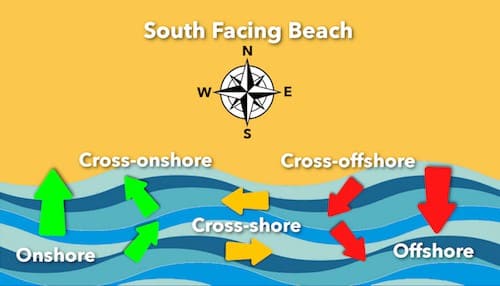
DESCRIBING YOUR POSITION IN RELATION TO OTHER PEOPLE, OBJECTS AND THE WIND
Finally, we do not only need to describe the wind direction; we also need to describe the position of a person or object in relation to the wind. We do this with the terms upwind, downwind and crosswind.
If you are standing with the wind blowing on your back and there is a palm tree 30 meters in front of you. You would describe the tree as being 30m downwind of you, or you could describe yourself as being 30m upwind of the tree. If the palm tree were to your right or left, it would be crosswind of you, and you crosswind of the trees.
It is important that we know our bearings in relation to objects and other people so that we may recognise that we need to distance ourselves from hazards to be safe, and also so that we can adhere to rights of way as we ride around the kiters and water users.
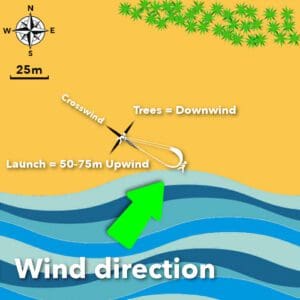
RECAP
- A cross-onshore wind direction is the easiest to kiteboard in.
- Onshore and cross-onshore winds are smooth (less gusty) and will return the rider to shore so they are the safest direction.
- Offshore and cross-offshore winds are very gusty as the wind passes over land and they require boat support.
- When describing wind direction by compass points, we state the direction the wind is coming from. A wind blowing from South to North is called a Southerly wind.
- When describing our position in relation to other objects or people, we do this in relation to the wind direction. We can be upwind, downwind or crosswind to another person or object.

